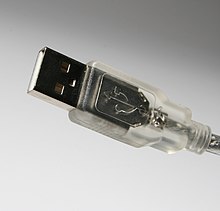
USB can connect computer peripherals such as mice, keyboards, digital cameras, printers, personal media players, flash drives, Network Adapters, and external hard drives. For many of those devices, USB has become the standard connection method.
USB was designed for personal computers, but it has become commonplace on other devices such as smartphones, PDAs and video game consoles, and as a power cord. As of 2008[update], there are about 2 billion USB devices sold per year, and approximately 6 billion total sold to date.
Unlike the older connection standards RS-232 or Parallel port, USB connectors also supply electric power, so many devices connected by USB do not need a power source of their own.
History
The USB is a standard for peripheral devices. A group of seven companies began development on it in 1994: Compaq, DEC, IBM, Intel, Microsoft, NEC and Nortel. The goal was to make it fundamentally easier to connect external devices to PCs by replacing the multitude of connectors at the back of PCs, addressing the usability issues of existing interfaces, and simplifying software configuration of all devices connected to USB, as well as permitting greater bandwidths for external devices. The first silicon for USB was made by Intel in 1995.
The original USB 1.0 specification, which was introduced in January 1996, had a data transfer rate of 1.5 Mbit/s. The first widely used version of USB was 1.1, which was released in September 1998. It allowed for a 12 Mbit/s data rate for higher-speed devices such as disk drives, and a lower 1.5 Mbit/s rate for low bandwidth devices such as joysticks.
The USB 2.0 specification was released in April 2000 and was standardized by the USB-IF at the end of 2001. Hewlett-Packard, Intel, Lucent Technologies (now Alcatel-Lucent), NEC and Philips jointly led the initiative to develop a higher data transfer rate, with the resulting specification achieving 480 Mbit/s, a fortyfold increase over the original USB 1.1 specification.
The USB 3.0 specification was published on 12 November 2008. Its main goals were to increase the data transfer rate (up to 5Gbps), to decrease power consumption, to increase power output, and to be backwards-compatible with USB 2.0. USB 3.0 includes a new, higher speed bus called SuperSpeed in parallel with the USB 2.0 bus. For this reason, the new version is also called SuperSpeed. The first USB 3.0 equipped devices were presented in January 2010.
![]()






